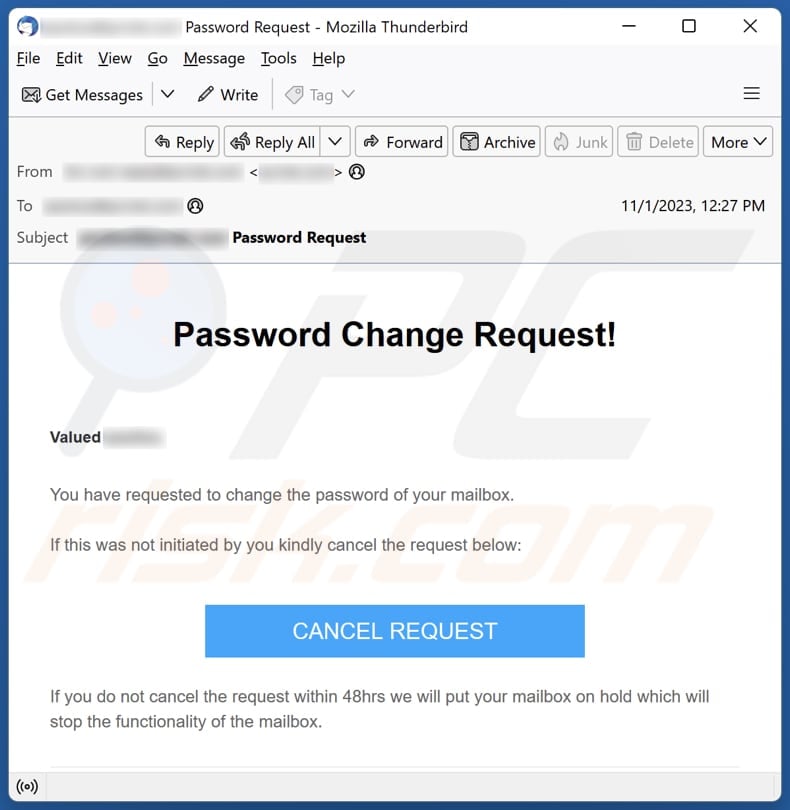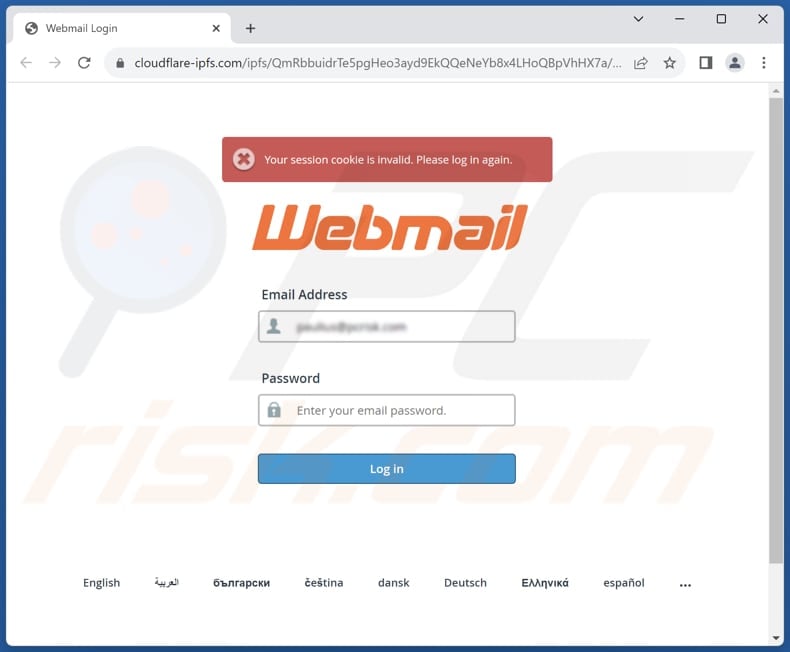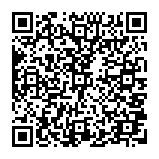How to avoid falling for scams like Password Change Request phishing letter
![]() Written by Tomas Meskauskas on
Written by Tomas Meskauskas on
What is "Password Change Request"?
This email has been identified as a fraudulent attempt orchestrated by scammers seeking to obtain personal information. Such deceptive emails are commonly referred to as phishing emails. In this instance, the email masquerades as a communication from an email service provider and contains a link leading to a fake website.

More about the "Password Change Request" scam email
In this phishing email, recipients are informed of a supposed password change request for their mailbox. The message urges recipients to cancel the request by clicking on the provided link labeled "CANCEL REQUEST" if they did not initiate the change.
A threat is conveyed that failing to cancel the request within 48 hours will result in the mailbox being put on hold, disrupting its functionality. The email employs urgency and fear tactics to manipulate recipients into taking immediate action, intending to lead them to a fake login website and extract sensitive information.
The page opened via the "CANCEL REQUEST" requests for email account login credentials (email address and password) that scammers can misuse in various ways. Firstly, these credentials provide unauthorized access to the victim's email account, allowing the scammers to monitor, read, and even intercept incoming and outgoing emails.
This unauthorized access can lead to the exposure of sensitive personal and financial information contained within emails, posing a significant threat to the victim's privacy. Furthermore, scammers may misuse the compromised email account to launch additional phishing attacks.
By sending deceptive emails from the victim's account, they can attempt to trick contacts into divulging further sensitive information or clicking on malicious links, thereby expanding their pool of potential victims.
Additionally, scammers may exploit the compromised account for identity theft, using the obtained information to carry out fraudulent activities, gain unauthorized access to other accounts, or engage in financial scams.
| Name | Password Change Request Email Scam |
| Threat Type | Phishing, Scam, Social Engineering, Fraud |
| Fake Claim | Recipients have requested to change the password for their email accounts. |
| Disguise | Letter from an email service provider |
| Symptoms | Unauthorized online purchases, changed online account passwords, identity theft, illegal access of the computer. |
| Distribution methods | Deceptive emails, rogue online pop-up ads, search engine poisoning techniques, misspelled domains. |
| Damage | Loss of sensitive private information, monetary loss, identity theft. |
| Malware Removal (Windows) | To eliminate possible malware infections, scan your computer with legitimate antivirus software. Our security researchers recommend using Combo Cleaner. |
Similar scam emails in general
Emails of this kind typically mimic official correspondence from trustworthy entities such as banks, email providers, or government agencies, employing logos and certain language to create a convincing facade. Phishing emails commonly evoke a sense of urgency or alarm, urging recipients to take immediate action, such as clicking on a link or providing sensitive information.
Additionally, these emails often exploit psychological manipulation, such as fear or curiosity, to coerce recipients into complying with the scammers' demands. Moreover, links and attachments sent by cybercriminals can be used to deliver malware.
Examples of phishing campaigns are "IMAP Termination Process", "Aknowledged Response", and "American Express Account Confirmation".
How do spam campaigns infect computers?
Users expose their computers to potential infections through email by interacting with attachments that harbor malware, often camouflaged as harmless files or documents. Such attachments may contain viruses, ransomware, or other forms of malware, compromising the user's system upon execution. Another avenue for infection is clicking on links embedded within emails.
In order to distribute malware, cybercriminals frequently rely on executable files, JavaScript files, and various document formats like PDFs and Office documents.
How to avoid installation of malware?
Exercise caution when interacting with emails, especially those from unfamiliar or suspicious sources. Refrain from opening attachments or links unless their legitimacy is verified. Be skeptical of unexpected emails urging immediate action.
Keep your operating system, software, and antivirus programs up-to-date. Avoid downloading software or files from unofficial or dubious sources. Additionally, exercise caution when browsing online, steering clear of suspicious websites, ads, and pop-ups.
If you have already opened malicious attachments, we recommend running a scan with Combo Cleaner Antivirus for Windows to automatically eliminate infiltrated malware.
Text presented in the "Password Change Request" email letter:
Subject: ******** Password Request
Password Change Request!
Valued ********,
You have requested to change the password of your mailbox.If this was not initiated by you kindly cancel the request below:
CANCEL REQUEST
If you do not cancel the request within 48hrs we will put your mailbox on hold which will stop the functionality of the mailbox.
******** Notifications.
Screenshot of the phishing website promoted via this scam campaign:

Instant automatic malware removal:
Manual threat removal might be a lengthy and complicated process that requires advanced IT skills. Combo Cleaner is a professional automatic malware removal tool that is recommended to get rid of malware. Download it by clicking the button below:
▼ DOWNLOAD Combo Cleaner
By downloading any software listed on this website you agree to our Privacy Policy and Terms of Use. To use full-featured product, you have to purchase a license for Combo Cleaner. 7 days free trial available. Combo Cleaner is owned and operated by Rcs Lt, the parent company of PCRisk.com read more.
Quick menu:
- What is Password Change Request phishing email?
- Types of malicious emails.
- How to spot a malicious email?
- What to do if you fell for an email scam?
Types of malicious emails:
![]() Phishing Emails
Phishing Emails
Most commonly, cybercriminals use deceptive emails to trick Internet users into giving away their sensitive private information, for example, login information for various online services, email accounts, or online banking information.
Such attacks are called phishing. In a phishing attack, cybercriminals usually send an email message with some popular service logo (for example, Microsoft, DHL, Amazon, Netflix), create urgency (wrong shipping address, expired password, etc.), and place a link which they hope their potential victims will click on.
After clicking the link presented in such email message, victims are redirected to a fake website that looks identical or extremely similar to the original one. Victims are then asked to enter their password, credit card details, or some other information that gets stolen by cybercriminals.
![]() Emails with Malicious Attachments
Emails with Malicious Attachments
Another popular attack vector is email spam with malicious attachments that infect users' computers with malware. Malicious attachments usually carry trojans that are capable of stealing passwords, banking information, and other sensitive information.
In such attacks, cybercriminals' main goal is to trick their potential victims into opening an infected email attachment. To achieve this goal, email messages usually talk about recently received invoices, faxes, or voice messages.
If a potential victim falls for the lure and opens the attachment, their computers get infected, and cybercriminals can collect a lot of sensitive information.
While it's a more complicated method to steal personal information (spam filters and antivirus programs usually detect such attempts), if successful, cybercriminals can get a much wider array of data and can collect information for a long period of time.
![]() Sextortion Emails
Sextortion Emails
This is a type of phishing. In this case, users receive an email claiming that a cybercriminal could access the webcam of the potential victim and has a video recording of one's masturbation.
To get rid of the video, victims are asked to pay a ransom (usually using Bitcoin or another cryptocurrency). Nevertheless, all of these claims are false - users who receive such emails should ignore and delete them.
How to spot a malicious email?
While cyber criminals try to make their lure emails look trustworthy, here are some things that you should look for when trying to spot a phishing email:
- Check the sender's ("from") email address: Hover your mouse over the "from" address and check if it's legitimate. For example, if you received an email from Microsoft, be sure to check if the email address is @microsoft.com and not something suspicious like @m1crosoft.com, @microsfot.com, @account-security-noreply.com, etc.
- Check for generic greetings: If the greeting in the email is "Dear user", "Dear @youremail.com", "Dear valued customer", this should raise suspiciousness. Most commonly, companies call you by your name. Lack of this information could signal a phishing attempt.
- Check the links in the email: Hover your mouse over the link presented in the email, if the link that appears seems suspicious, don't click it. For example, if you received an email from Microsoft and the link in the email shows that it will go to firebasestorage.googleapis.com/v0... you shouldn't trust it. It's best not to click any links in the emails but to visit the company website that sent you the email in the first place.
- Don't blindly trust email attachments: Most commonly, legitimate companies will ask you to log in to their website and to view any documents there; if you received an email with an attachment, it's a good idea to scan it with an antivirus application. Infected email attachments are a common attack vector used by cybercriminals.
To minimise the risk of opening phishing and malicious emails we recommend using Combo Cleaner Antivirus for Windows.
Example of a spam email:

What to do if you fell for an email scam?
- If you clicked on a link in a phishing email and entered your password - be sure to change your password as soon as possible. Usually, cybercriminals collect stolen credentials and then sell them to other groups that use them for malicious purposes. If you change your password in a timely manner, there's a chance that criminals won't have enough time to do any damage.
- If you entered your credit card information - contact your bank as soon as possible and explain the situation. There's a good chance that you will need to cancel your compromised credit card and get a new one.
- If you see any signs of identity theft - you should immediately contact the Federal Trade Commission. This institution will collect information about your situation and create a personal recovery plan.
- If you opened a malicious attachment - your computer is probably infected, you should scan it with a reputable antivirus application. For this purpose, we recommend using Combo Cleaner Antivirus for Windows.
- Help other Internet users - report phishing emails to Anti-Phishing Working Group, FBI’s Internet Crime Complaint Center, National Fraud Information Center and U.S. Department of Justice.
Frequently Asked Questions (FAQ)
Why did I receive this email?
Getting a phishing email can occur due to multiple factors, and it is crucial to recognize that these attacks are frequently non-selective. Cybercriminals deploy a broad strategy, distributing phishing emails to a sizable audience in anticipation that the scam will deceive some recipients.
I have provided my personal information when tricked by this email, what should I do?
Immediately change the password for the email account that was compromised. Review recent activity on your email account to ensure there are no unauthorized changes or actions. If you use the same or similar passwords for other accounts, consider changing them as well. Report the phishing email to your email provider.
I have downloaded and opened a malicious file attached to an email, is my computer infected?
If the file you downloaded and opened was an executable (.exe), there is a higher likelihood of infection. On the other hand, if the file was a document (e.g., .pdf, .doc), the risk of infection may be lower, as some document formats may require additional actions, such as enabling macros, for the malware to take effect.
I have read the email but did not open the attachment, is my computer infected?
Merely opening an email poses no harm on its own. The potential risk arises when users interact with the email by clicking on embedded links or opening attached files, actions that may result in system infections.
Will Combo Cleaner remove malware infections that were present in email attachment?
Combo Cleaner is well-equipped to identify and eradicate the majority of known malware infections. Advanced forms of malware tend to hide in intricate parts of the system. Consequently, performing a thorough full system scan becomes imperative to ensure the comprehensive detection and elimination of potential threats.


▼ Show Discussion